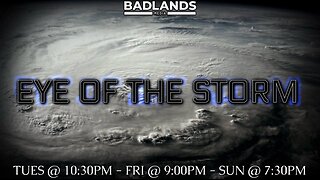Premium Only Content

Exploring the Nature of Evil: Literal and Metaphorical Perspectives.
What does it mean to be evil? The word conjures images of darkness, suffering, and malevolence. But is evil always so straightforward, confined to clear-cut definitions of good and bad? The concept of evil is complex, nuanced, and subjective, spanning literal interpretations, rooted in real-world actions, to more abstract, metaphorical representations that capture the darker shades of human nature.
Literal Evil: Actions, Intent, and Consequences.
At its core, literal evil is defined by actions that cause deliberate harm or suffering to others. This type of evil is often tied to intent—when an individual consciously chooses to inflict pain, damage, or destruction for personal gain or out of sheer malice. History is replete with examples of such evil: genocides, serial murders, terrorism, and systemic abuses of power. These acts are universally condemned because they are grounded in a tangible reality of suffering.
Evil in this literal sense is usually framed around clear moral boundaries. The perpetrators know their actions are wrong, yet they proceed anyway. This is where intent becomes crucial. An accidental harm, no matter how devastating, isn’t considered evil in the same way as a calculated act of violence. Here, evil is something that can be judged and prosecuted—an observable deviation from societal norms of morality and legality.
But the literal interpretation of evil doesn’t always cover the full spectrum of harmful actions. What about the so-called “banality of evil,” where individuals, like bureaucrats or soldiers, commit atrocities not out of malice but through blind obedience or indifference? This type of evil is subtle and insidious. It’s not driven by hatred, but by apathy and disconnection from the suffering of others. It raises uncomfortable questions about how easy it is for ordinary people to become complicit in evil when they cease to see others as human.
Metaphorical Evil: The Darkness Within.
Metaphorical evil, on the other hand, is more abstract, symbolising the darker aspects of human experience: greed, envy, wrath, and pride. It’s not always about direct harm but rather about the seeds of corruption that lie within us all. While literal evil is often a matter of actions, metaphorical evil is more a question of character and inner struggle.
This type of evil doesn’t always manifest in grandiose acts of violence or oppression. It can be seen in the small betrayals, the subtle manipulations, and the unchecked desires that lead people down destructive paths. It’s the friend who undermines you out of jealousy, the corporate leader who sacrifices ethics for profit, or the lover who deceives out of insecurity. These actions aren’t always illegal or even outwardly malicious, but they erode trust, sow discord, and leave scars on the soul.
Metaphorically, evil can be seen as a force that distorts the self—a moral corrosion that leads us to dehumanise others and ultimately lose our own humanity. This is why literature, religion, and mythology often depict evil as a presence lurking within, a whispering voice that tempts individuals to betray their values and suc
cumb to their basest instincts.
The Intersection: When Literal and Metaphorical Evil Converge.
Interestingly, the literal and metaphorical forms of evil often overlap. Literal acts of violence, oppression, and harm are typically born from metaphorical roots—greed, lust for power, or an insatiable desire for control. Historical tyrants and infamous criminals rarely start off as monsters; they are often driven by desires or beliefs that, unchecked, grow into something far more sinister. When metaphorical evil is allowed to flourish unchecked, it can translate into literal harm.
Take, for example, the archetype of the corrupt politician. At first, their small compromises may seem harmless—bending a rule here, accepting a bribe there. But over time, these decisions create a mindset that rationalises greater evils. What begins as a metaphorical rot within their character transforms into literal corruption, oppression, and exploitation of others.
Defining Evil: A Spectrum Rather Than a State.
Ultimately, to be evil is not always a fixed state of being. It’s often a spectrum, defined not just by what people do but by what they choose to ignore and tolerate. Apathy, self-interest, and the failure to act against harm can be just as evil as direct malevolence. The literal and metaphorical definitions of evil blend into one another, reflecting a broader understanding that evil is not just about what is done, but also about what is allowed to be.
This ambiguity is what makes evil such a powerful and unsettling concept. It’s not something that can be fully exorcised or legislated away. It’s a part of human nature, a shadow that we all carry within us. Whether it emerges as literal cruelty or lingers as metaphorical darkness, evil is ultimately a reminder of the thin line between moral integrity and moral failure. Recognizing this fact is perhaps the first step to truly understanding what it means to be evil.
READ MORE -
Exploring the Nature of Evil: Literal and Metaphorical Perspectives.
https://mattsmemos5.wordpress.com/2024/10/07/exploring-the-nature-of-evil-literal-and-metaphorical-perspectives/
-
 8:05:10
8:05:10
CHiLi XDD
12 hours agoPart 2 F Em UP Friday!
57K3 -
 5:14:28
5:14:28
FreshandFit
11 hours agoCall-In Show
77.1K25 -
 3:00:07
3:00:07
JustPearlyThings
12 hours agoWhy Do Modern Women Think Disrespecting Their Husbands Publicly Is Funny? Call-In Show | Pearl Daily
90.2K31 -
 1:35:17
1:35:17
Badlands Media
1 day agoEye of the Storm Ep. 241
103K49 -
 2:05:58
2:05:58
TimcastIRL
12 hours agoTrump Just REVOKED Legal Status Of 530,000 Migrants, Deportations NOW w/ Alex Stein | Timcast IRL
217K319 -
 3:39:01
3:39:01
I_Came_With_Fire_Podcast
16 hours agoCHINA MILITARY PURGE | TESLA OWNERS DOXXED | NGAD F-47
55.5K16 -
 5:44:43
5:44:43
Shield_PR_Gaming
17 hours agoSome Gray Zone Warfare with Followers & more games!
72.7K4 -
 31:38
31:38
Michael Franzese
13 hours agoTony Accardo: The Genius That Built Chicago’s Most Powerful Empire
72.2K4 -
 45:40
45:40
BonginoReport
15 hours agoCritics Give Disney’s Feminist “Snow White” a Rotten Apple (Ep.10) - Nightly Scroll w Hayley 03/21/2025
130K159 -
 1:47:40
1:47:40
Kim Iversen
17 hours agoWhy Did Sarah Ashton-Cirillo Help Jail Gonzalo Lira? His Side of The Story
119K240